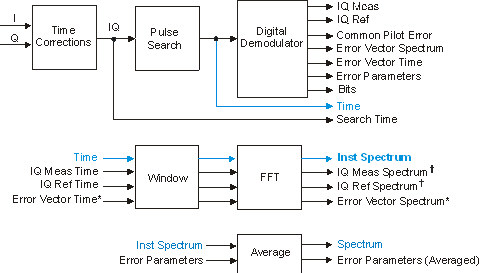Inst Spectrum (802.11b/g DSSS/CCK/PBCC)
When 802.11b/g DSSS Direct sequence spread spectrum. The data transmission scheme (sometimes referred to as a "'modulation" scheme) used in 802.11b WLANs. DSSS uses a radio transmitter operating at a fixed centre frequency, but using a relatively broad range of frequencies, to spread data transmissions over a fixed range of the frequency band. 802.11a and 802.11g (when not operating in 802.11b mode) use Orthogonal Frequency Division Multiplexing (OFDM)./CCK complementary code keying/PBCC packet binary convolutional code Demodulation is enabled, the trace is the frequency spectrum display of the pre-demodulated time data. The time data is Windowed and FFTed to create the Inst Spectrum display.
If averaging is on, the trace does not show the effects of averaging. To see the effects of averaging, use the Spectrum trace data.
The following block diagram is part of the Digital Demodulation Block Diagram and shows the Inst Spectrum signal flow.
The trace is derived from pre-demodulated time data, which is 20% longer than the result length.

See Also
